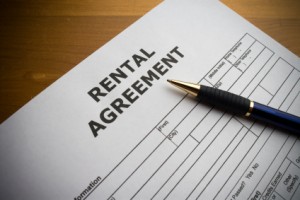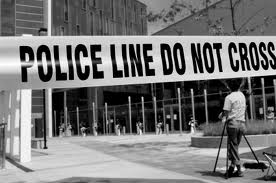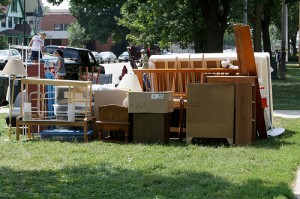Posted by Teresa on July 6, 2011 under Landlord Paperwork and Forms, Landlord Tips, Lease and Rental Agreements | 
 Most landlords we know require each person over 18 who lives in a rental unit to be on the lease. Most require each roommate to fill out a lease application, and undergo tenant background and credit checks. And that’s the extent of involvement for most landlords we know.
Most landlords we know require each person over 18 who lives in a rental unit to be on the lease. Most require each roommate to fill out a lease application, and undergo tenant background and credit checks. And that’s the extent of involvement for most landlords we know.
Roommates don’t always work out, which can cause headaches for landlords. If you’ve experienced your share of roommate drama, you can help educate your tenants to be better roommates—which in turn can make them better tenants for you.
Why not provide all of your tenants with a Roommate Agreement? Here’s what it can do for you:
- Facilitate better tenant relationships
- Minimize roommate arguments
- Increase awareness about legal responsibilities
While the agreement will not alter the terms of the lease each tenant is subject to, it serves to clarify some of the issues roommates often have with each other. Be sure that the agreement states that the roommates are jointly and severally liable for all terms of the lease/rental agreement. And of course, have a legal professional review it before you hand it over to your tenants.
What to Include in a Roommate Agreement
- Address of rental unit and lease beginning and ending dates.
- Name of each roommate, share of rent and security deposit each is responsible for, and which bedroom is his or hers.
- Security deposit rules: an agreement that whichever roommate is clearly responsible for damages will pay any applicable fees in full. All roommates agree to share equally in the cost of other fees and damages.
- Utilities: Determine in whose name the utilities (electricity, water, gas, cable, phone) will be and how the roommates will split and pay the bills.
- Subletting: State whether subletting is or is not allowed under the terms of the lease. If so, specify guidelines.
- Guests: Specify that each roommate is responsible for guest behavior, determine where each guest may stay, and the consequences when guests cause trouble or any damages. Place a limit on the number of days a guest may stay, according to the terms of the lease and the roommates’ comfort level. Specify whether guests may smoke and who is responsible for cleaning up after them.
- Quiet hours: state when roommates agree to observe quiet hours for sleep, study, etc.
- Pets: Guidelines for pet owners, according to the terms of the lease.
- Smoking: If the lease allows smoking, this section can spell out whether or not it is allowed by the roommates, and if so, where.
- General household rules: State who is responsible for trash and recycling, where to park vehicles and bicycles, guidelines for cleaning, sharing food, etc.
All roommates should sign and date the roommate agreement. While these guidelines may seem obvious, a formal agreement where all terms are spelled out and agreed to in the beginning can avoid many typical roommate problems. Good roommates make better tenants, and accepting the responsibilities that go along with living together can make the situation much more pleasant for everyone involved!
Posted by Teresa on March 22, 2011 under Landlord Paperwork and Forms | 
 Harry the landlord notices a broken window in Unit A during a routine maintenance visit to Unit B. He knocks on Unit A’s door to arrange a repair and is greeted by someone he’s never seen, much less approved to live there. The man asks Harry what he wants; Harry explains that he is the building owner. “Oh. I’m visiting,” the man replies.
Harry the landlord notices a broken window in Unit A during a routine maintenance visit to Unit B. He knocks on Unit A’s door to arrange a repair and is greeted by someone he’s never seen, much less approved to live there. The man asks Harry what he wants; Harry explains that he is the building owner. “Oh. I’m visiting,” the man replies.
Later, Harry asks the tenant in Unit B if she has seen the man in Unit A. “You mean Scott?” she answers. “He’s been there for a couple of months.”
There is a fine line between a visitor and an unauthorized resident. Explaining the difference to your tenants can be tough—but it’s something a landlord must do to avoid the risk and potential problems that come when unscreened and unauthorized tenants live in your rental property.
Luckily, making sure you’re legally covered is easy. Just make sure your lease specifies what tenants can and cannot do when it comes to guests.
Harry’s lease does prohibit unauthorized residents. When he brings this to Unit A’s attentions, the tenant replies that her friend is not a resident—he’s just visiting.
Harry reviewed his rental agreement and realized it didn’t specify any time limit for guests or visitors. He revised it to read:
“Persons other than those specifically listed on the Rental Agreement shall be strictly prohibited from staying in the rental unit for more than 7 consecutive days, or a total of 20 days in any 12-month period. Tenant shall notify Owner in writing any time the Tenant expects any guest will be staying in excess of the time limits herein. Additional residents will be subject to full screening procedures, additional rent and security deposit. Unauthorized residents are a violation of this Rental Agreement and grounds for termination of the Rental Agreement.”
Harry was still within his rights to notify the tenant in Unit A that her unauthorized guest had overstayed his welcome and that he would need to move or she would be in violation of her lease. Luckily, she didn’t push the issue and the visitor was soon gone.
Don’t expose your tenants or your business to the risks of unscreened residents. Require your tenants to clear it with you before allowing anyone to move in. Require the new roommate to fill out a lease application and undergo tenant screening and a background check before they unpack their first box of belongings!
Posted by Teresa on March 9, 2011 under Landlord Paperwork and Forms, Landlord Tips | 
 Just when a landlord thinks that business is quiet—or even under control—something unexpected happens. Like you receive notice that a tenant is moving out. If it’s a great tenant, you might feel a pang of regret; if not, perhaps you’ll hear a sigh of relief.
Just when a landlord thinks that business is quiet—or even under control—something unexpected happens. Like you receive notice that a tenant is moving out. If it’s a great tenant, you might feel a pang of regret; if not, perhaps you’ll hear a sigh of relief.
Either way, the minute you receive that notice is when the tenant transition begins.
- Most leases require a 30- or 60-day notice when either party is intending to not renew. It’s a good idea to regularly review your lease expiration dates so you’re not surprised by a tenant’s notice. If you see one that will soon expire, go ahead and check in with your tenants to see if they’re planning on staying or leaving. The more time you have to prepare, the better.
- Of course, you’ll want to begin the search for a qualified new tenant immediately. Start by advertising in all your usual places, and put signs up in the neighborhood and on the property.
- Let the vacating tenant know you’ll be showing the rental unit to prospective new tenants. Try to be respectful of their time and privacy; but do insist on your rights to show the unit if they prove to be difficult about scheduling.
- You might want to make an appointment with your tenant to take a quick look through the unit to determine any work that needs to be done after they move out. Be sure to explain that this visit is NOT a move-out inspection, which will be performed after the unit is empty. This is just a helpful way to plan any painting, repairs and upgrades that will need to be completed before the next tenant moves in.
- Schedule the move-out inspection for moving day. Let your tenant know they’ll need time to move their belongings and clean the unit before you arrive. Remind them to pull out their move-in/move-out checklist to see what items you’ll be inspecting. Bring your copy of this document with you when you inspect.
- Once the rental unit is empty, you should be ready to immediately begin painting, repairs, replacing fixtures or floor tiles, and any pest treatment or carpet cleaning that is needed.
- Continue to show the property while repairs and painting are taking place. Remind prospective tenants that the unit will be completely ready for move-in day. Have photos available to show.
Posted by Teresa on January 14, 2011 under Landlord Paperwork and Forms, Landlord Tips | 
 If you’re a landlord who is selling your rental property, here are some guidelines for notifying your tenants. Laws and regulations vary according the city and state where you live, so check yours for specifics.
If you’re a landlord who is selling your rental property, here are some guidelines for notifying your tenants. Laws and regulations vary according the city and state where you live, so check yours for specifics.
- Double-check your lease, which may or may not address the sale of the property. Many large apartment building change hands without the tenants knowing, but for single family residences, small buildings and duplexes, it’s more difficult to show and sell a property without tenants knowing something is going on.
- If a tenant asks what’s up, be honest. Reassure them that the new owner will welcome them as tenants. Do what you can to avoid losing any tenants before the sale is final.
- It’s not generally required that you notify tenants that the building is going on the market. However, if you need entry to a unit to show a potential buyer, follow the standard notification period you use before entering a tenant’s unit.
- Remember that happy tenants are a big selling point. Try to avoid numerous interruptions and make an attempt to accommodate the tenant’s schedule.
- Most questions you receive will be regarding security deposits. Let tenants know if you and the buyer decide to:
a. refund all security deposits so new owner can collect them anew;
b. transfer existing security deposits to the new owner.
- When the sale is completed, send a notification to each tenant with the effective date that you will no longer own the building or accept rent payments. Ideally, this would arrive at the same time as a letter from the new owner, directing tenants where and to whom to send rent payments.
- State laws vary, but in general, once the sale is completed, the new owner is obligated to honor all existing leases. Whether they do or not—or whether tenants wish to continue with the lease or not—is no longer your problem.
Posted by Teresa on January 9, 2011 under Landlord Paperwork and Forms, Landlord Tips | 
 Our previous post about a cop-calling tenant raised some additional questions from landlords:
Our previous post about a cop-calling tenant raised some additional questions from landlords:
Marilyn owns a duplex and lives in one unit. She rents the other unit to a tenant who confided in Marilyn that she is afraid that her ex-boyfriend was stalking her. The man was driving past the house several times a day, and the tenant had recently seen his car in the parking lots of the mall and grocery store where she had been shopping. She was worried, and wanted to let Marilyn know about his actions in case he became threatening.
Marilyn wants to protect her tenant and her property, but is rightfully concerned about getting too involved in the tenant’s situation. “I’m planning on calling the police if I ever see him near my property,” she said.
Police might recommend that Marilyn allow her tenant to take care of this problem directly, since the tenant is the legal resident of her unit. An attorney might say that Marilyn must take some sort of action to avoid being held responsible in the event a criminal action takes place against the tenant.
Encouraging a tenant who is being harassed to obtain a restraining order is certainly within a landlord’s area of responsibility. And as soon as Marilyn feels threatened by the ex-boyfriend, she too can seek a restraining order.
It is never a good idea to attempt any confrontation with a violent person. Stalking behavior is not acceptable behavior—it is a warning sign that should not be ignored. While it is understandable that Marilyn wants to protect her tenant and her property, it’s best to follow the law and let the police handle every confrontation with the ex-boyfriend.
Scott’s tenants were robbed soon after they moved into one of his apartment units. The thief took their TV, a computer, some cash and jewelry. The tenants claimed that Scott failed to protect them by providing proper door locks. Scott is curious about the limit of protection a landlord owes his tenants in this situation.
Robberies happen every day, in every level of neighborhood in America. A landlord cannot prevent a criminal who really wants to get in from entering a rental unit. However, solid locks on the entry doors and windows are necessary, and if your rental properties are lacking them, now is a good time to remedy that situation—before a robbery or something worse happens.
To avoid any question of liability, every rental agreement should include a clause requiring tenants to purchase renter’s insurance. Further, it should explain that the landlord’s insurance does not cover theft of the renter’s contents. If a tenant does not carry required insurance, the landlord could move to eviction.
Pre-screen all tenants as part of your standard application process. Background and credit checks will help ensure you rent to qualified tenants. For more landlord resources, including forms and information on tenant screening, turn to E-Renter.com.
Posted by Teresa on December 23, 2010 under Housing Trends, Landlord Paperwork and Forms, Tenant Credit Checks | 
 Short-term leases are becoming more popular in some areas of the country. One trend is that homeowners who sell a home are less willing to buy right away, so while they wait and see what the market will bring, they rent for a while. Another factor is the toll the economic crisis took on renters’ credit scores. Landlords are less willing to take chances on one-year leases, so often a month-to month or six-month lease is a great option.
Short-term leases are becoming more popular in some areas of the country. One trend is that homeowners who sell a home are less willing to buy right away, so while they wait and see what the market will bring, they rent for a while. Another factor is the toll the economic crisis took on renters’ credit scores. Landlords are less willing to take chances on one-year leases, so often a month-to month or six-month lease is a great option.
When the economy and job market are both doing well, the ideal situation for a landlord is a one-year lease with a strong tenant. But even though the rental markets across the country are starting to show improvement, many landlords are far from the ideal—and they still need to fill rental units.
When credit scores are less than perfect, and home sellers are knocking on your door, looking for short-term leases, it makes sense to adjust your lease terms from one-year to six-month or month-to-month.
Month-to-month leases mean that at the end of any month, the tenant can simply move—or the landlord can end the lease. Most leases require notice on each side, but if neither side ends the lease, it continues for another month.
7 Advantages of Short-term Leases:
- Your rental units could be occupied instead of empty
- Improved cash flow
- Possibility of higher rent negotiation
- Easier transition between tenants (less clean-up and maintenance)
- Larger pool of possible tenants
- You can get rid of a bad tenant more quickly
- For month-to-month leases, the rent can be adjusted at any time
Remember, no matter what the length of the lease, proper tenant screening is the most important step you can take prior to signing it. Conduct a thorough tenant credit check and background check and you’ll feel better about offering a lease to short-term tenants.
Posted by Teresa on December 14, 2010 under Landlord Paperwork and Forms, Landlord Tips | 
 Many tenants notify landlords of their plans to move at the end of a lease by mentioning it in passing. Others assume that, if they haven’t signed a new lease, the landlord knows they are moving and they don’t need to notify.
Many tenants notify landlords of their plans to move at the end of a lease by mentioning it in passing. Others assume that, if they haven’t signed a new lease, the landlord knows they are moving and they don’t need to notify.
It’s a good idea to require tenants to provide a written notice of their intent to move. Many states require it, and if you use a well-written lease, it probably does as well.
The Advantages of Written Notices
Requiring tenants to put their intentions in writing is a good idea for several reasons:
- It eliminates the mix-up that can occur with verbal notifications
- It keeps the landlord/tenant relationship more businesslike
- It may be state law
- Written notices leave nothing to the imagination
- You won’t forget the tenant’s move-out date, which can lead to problems
- You’ll have time to prepare the security deposit return or deductions
What to Include on a Tenant’s Notice of Intent to Vacate Unit
Use a simple form, either one you obtain online or one you create yourself. You can provide it to tenants at lease signing, although it’s not likely they’ll keep it around long enough to turn it in at the end of the lease. Many landlords provide a form to tenants 60 or 90 days before the lease is up, with instructions to return it within 30 days of the end of the lease, if they plan to move.
The form should include:
- The date the form was completed;
- The name of the landlord or property management company;
- The address of the rental unit;
- Legal language including: The undersigned Tenant (name) hereby gives written notice of intent to vacate the rental unit at (address) on (date);
- A statement that the tenant understands they are responsible for rent until the end of the current lease or the day they vacate the unit, whichever is later;
- A statement that in accordance with the lease, the landlord is allowed reasonable access with advance notice to show the rental unit to prospective renters or contractors;
- A line for the tenant to sign and date the form.
As you can see, a thorough tenant move-out form covers all the bases: the date of the move-out, the day the rent is to be paid through, and permission to show the unit or allow access to workers.
Landlords who want even more information can include a short survey on the form, asking why the tenant is moving and if there is anything that could have been done to keep him or her as a tenant. This type of feedback is extremely valuable!
Pre-screen all tenants as part of your standard application process. Background and credit checks will help ensure you rent to qualified tenants. For more landlord resources, including forms and information on tenant screening, turn to E-Renter.com.
Posted by Teresa on December 3, 2010 under Landlord Paperwork and Forms, Landlord Tips | 
 Have a tenant moving out? Wouldn’t you love for him or her to leave your rental unit in a state that will make you smile? Why not just tell them exactly what you want? Sometimes tenants need to know your expectations. While there are no guarantees they will fulfill them, providing them with a tenant move-out checklist can make that more of a possibility.
Have a tenant moving out? Wouldn’t you love for him or her to leave your rental unit in a state that will make you smile? Why not just tell them exactly what you want? Sometimes tenants need to know your expectations. While there are no guarantees they will fulfill them, providing them with a tenant move-out checklist can make that more of a possibility.
And since most tenants want their entire security deposit returned, following a list can help them achieve that goal. A little education and open communication can go a long way toward a win-win situation for both landlord and tenant. Here are some items you might want to include on your list.
Move-Out Check List for Tenants
- All trash removed from premises, including patio and storage unit
- Closets emptied and vacuumed or mopped
- Bathroom clean, including tub, sink, toilet, vanity drawers, shelves, floor and baseboards
- Kitchen clean, including inside of cabinets and drawers, counters, sink, baseboards and floor
- Disposal in working order
- Refrigerator empty and clean, including shelves, drawers and door (do not turn off)
- Freezer empty and clean
- Dishwasher empty and clean
- Stove top and oven clean, including range hood
- Broiler pan clean
- Nails removed from walls
- Any spilled paint cleaned up
- Locks on windows and doors in working order
- All window blinds clean, in place and in working order
- Carpets vacuumed
- Linoleum and tile floors cleaned and mopped
- All ceiling fixtures, with light bulbs
- Windows clean
- Ceiling fans clean
- No carpet stains
- No scuffs on walls and floors
Starting with a list will help ensure that tenants are meeting your expectations—and help them get their security deposit back.
Posted by Teresa on November 30, 2010 under Landlord and Tenant FAQs, Landlord Paperwork and Forms | 
 Many landlords we hear from believe that a thorough, well-written and lawyer-approved lease should contain all the rules and regulations a tenant needs to follow. And that’s partly true. But there’s a difference between the terms of a lease and the everyday policies you want your tenants to follow.
Many landlords we hear from believe that a thorough, well-written and lawyer-approved lease should contain all the rules and regulations a tenant needs to follow. And that’s partly true. But there’s a difference between the terms of a lease and the everyday policies you want your tenants to follow.
As a rule, leases are where the legalese lives: the legal description of the property, legal names of the parties involved, legal termininology, and the landlord’s legal recourse when terms are not followed. The “house rules” are generally more relaxed in language, are more flexible (i.e., they can change at any time with notice to all residents) and are simply intended to help everyone get along better and live in harmony. They are generally not legally-enforceable documents.
A signature on your list of policies or house rules is just as important as the signature on the lease. You want to be clear that your tenant understands the rules and agrees to abide by them. Review them together at the time of the lease signing, and be sure to ask if any item needs clarification.
10 Items to Include in Your Rental Property Rules
- Noise: Emphasize that consideration for other tenants is required, and that while your rental unit is well-constructed, it is not to be considered sound proof. Noises that disrupt others’ quiet enjoyment are not allowed. Include quiet hours, if desired.
- Window Treatments: Here you’ll include whether or not blinds or drapes are included with the rental unit and what care they require. If no treatments are provided, you may want to specify what color and type of coverings are allowed—and what are not allowed (like aluminum foil).
- Keys: Any key replacement fee should be included here, as well as emergency lock-out fees if a tenant forgets his or her keys after hours.
- Inclement Weather Procedures: Inform tenants of your requests during times of high winds, low temperatures, or high rain, as well as thermostat settings when the rental unit is occupied for specified lengths of time.
- Trash and Recycling: Tenants need to know what can be recycled and where it goes, along with non-recyclable trash.
- Parking: Where tenants are allowed to park, how many vehicles each unit is allowed to keep onsite, where not to park, and whether or not non-running vehicles are allowed are some of the rules you’ll want to spell out here.
- Common Areas: Are tenants allowed to leave property in common areas like hallways, sidewalks and patios? Who is responsible for clearing snow and ice from walkways? Spell these things out here.
- Storage: Indicate where tenant storage is located, how they can access it, and any limitations (flammables, vehicles, dangerous chemicals, etc).
- Guests: Include things like where guests may park their vehicles and tenants’ responsibilities for their guests.
- Bicycle Parking: As bicycle commuting becomes more popular, many tenants will want to know where they can park their bikes. If you don’t want them chained to fences or balcony railings, specify where bike parking is allowed. Better yet, create special areas for bikes that are convenient and secure for cycling tenants.
Presenting a friendly list of house rules lets all tenants know what is expected of them and their fellow tenants. After all, who (besides fraternity kids, perhaps) wants to live in a place where there are no rules?
Posted by Teresa on November 16, 2010 under Landlord Paperwork and Forms, Landlord Tips | 
 If you’re a new investment property owner, starting out with all your paperwork in place is a must-do. That means compiling a lease agreement before you show your rental property to a prospective tenant—no matter how badly you want or need to rent it.
If you’re a new investment property owner, starting out with all your paperwork in place is a must-do. That means compiling a lease agreement before you show your rental property to a prospective tenant—no matter how badly you want or need to rent it.
Depending on where you live or where your rental property sits, you’ll have specific requirements unique to that state or locality. Be sure to familiarize yourself with the requirements of your state. But in general, the same provisions apply to most residential lease agreements no matter where the property is located. Most important: you need to be sure your lease agreement protects your property, your other tenants, and your business and personal resources.
Here’s a handy list of important provisions to include in a lease agreement:
- Legal Description of the leased premises: Be thorough. Include address, apartment number, city, state and zip code
- Term of Lease, including starting and ending date, with a provision to terminate early in accordance to provisions of the lease;
- Use and Occupancy: Explain how the property may be used (i.e. “for residential purposes”) and a list of names of authorized occupants.
- Rent Payment: State the amount of the rent, how it is to be paid, and penalties for late payments and insufficient funds. Consider a statement that no partial rent payments will be accepted (to avoid any problems if eviction becomes necessary).
- Security Deposit: state the amount of the deposit due upon signing the lease, as well as conditions for return of the security deposit.
- Default: Explain events of default and remedies.
- Utilities: State who pays for which utilities, including gas, telephone, cable, internet, electricity, water, sewer and trash pickup.
- Covenant of Quiet Enjoyment: This explains that the tenant, upon fulfilling his or her obligations under the lease, may peaceably and quietly enjoy the premises without interference by the landlord or a representative thereof.
- Assignment or Subletting: State whether or not the tenant is allowed to assign the lease or sublet the property, and if so, set the conditions under which they may.
- Pets: State whether or not pets are allowed and any restrictions related to type, size, breed, number, etc. Also include the amount of any required pet deposit or fee and conditions for return at the end of the lease.
- Maintenance, Damage and Alterations: States what maintenance the property owner is responsible for, what the tenant is required to do to maintain heating and plumbing systems, when routine maintenance inspections will be conducted, conditions under which the property owner may enter the unit for emergency repairs, and what alterations (paint, for example) are allowed.
- Insurance: Explain what type and level of renter’s insurance is required, if any.
- Abandonment: Defines what may be considered abandonment of the property by the tenant, and the landlord’s rights when it occurs.
- Right to Enter Premises: States when and under what circumstances the property owner or representative will be allowed to enter the rental unit, i.e., number of hours or days of notice.
Other notices, indemnities and covenants are likely to be required in a particular state or by your attorney. It’s always best to have legal counsel review your residential lease prior to using it.
Any forms or information provided by E-Renter USA is not intended to replace legal advice. You are advised to consult an attorney in your area, and to check all local and state regulations.
 Most landlords we know require each person over 18 who lives in a rental unit to be on the lease. Most require each roommate to fill out a lease application, and undergo tenant background and credit checks. And that’s the extent of involvement for most landlords we know.
Most landlords we know require each person over 18 who lives in a rental unit to be on the lease. Most require each roommate to fill out a lease application, and undergo tenant background and credit checks. And that’s the extent of involvement for most landlords we know.







